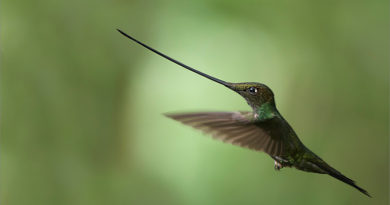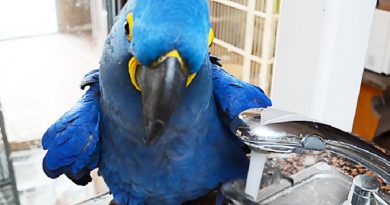20 Fun Facts About Flamingos (VIDEO)
Flamingos are the most instantly recognizable wading birds in the world. But what makes them so special that they capture the hearts of birders and non-birders alike? These fun flamingo facts and trivia may surprise you!
Flamingo Trivia
– There are only six species of flamingos in the world. Though several of those species have subspecies divisions and could eventually be split into different unique species.
Flamingos are found around the world from the Caribbean and South America to Africa, the Middle East and Europe. They are also popular guests in many zoos, aviaries, aquariums and botanical gardens well outside their native ranges.
– The word “flamingo” comes from the Spanish and Latin word “flamenco” which means fire. And refers to the bright color of the birds’ feathers. Not all flamingos are brightly colored, however. And some of the birds are mostly gray or white. The strength of a flamingo’s coloration comes from its diet.
– While flamingos are considered wading birds, the same classification as herons, egrets and cranes, they are most closely related to grebes genetically.
– Flamingos are strong but rare swimmers and powerful fliers, even though they’re most often seen just wading. Flamingos do fly very well, however, and many flamingos migrate or regularly fly between the best food sources and nesting grounds.
– When flying in a flock, the top speed of a flamingo can be as high as 35 miles per hour. They can seem ungainly or clumsy in flight, however. Because their long necks stretch out in front of their bodies and their long legs dangle well past their short tails.
– Flamingos hold their bills upside down while feeding, often for several hours a day. So they can filter out their food while skimming the water. They may seem to nibble or scoop at the surface of the water as they strain out small bits of algae, insects, brine shrimp and other food material.
– A flamingo chick’s bill is small and straight, without any distinct color patches. After a few months, their growing bills will develop the distinct “break” curve and they will be eating mostly on their own.

– Flamingos are monogamous birds that lay only a single egg each year. If that egg is lost or damaged, they do not typically lay a replacement. If a flamingo colony is ransacked by predators or hit with a natural disaster. It can take several years for the birds to recover and for their population to grow again.
– Parent flamingos feed their chicks exclusively crop milk for 5-12 days after hatching. Though young flamingos may continue to eat crop milk for up to two months as their bills develop. This high fat, high protein substance is not like mammalian milk, but is excellent nutrition for growing chicks. Parent flamingos produce crop milk in their digestive tracts and regurgitate it to feed their young.
– Flamingo chicks are born gray or white and take up to three years to reach their mature pink, orange or red plumage. Their young feathers are much less structured and fluffy than adult plumage. But that down provides excellent insulation to help keep baby flamingos warm.
– The pink, orange or red color of a flamingo’s feathers is caused by carotenoid pigments in their food. A wild flamingo’s diet includes shrimp, plankton, algae and crustaceans skimmed from different water sources. In zoos and aviaries, captive flamingos are often fed a specialized diet that will help preserve and enhance their unique coloration.
– The greater flamingo is the largest flamingo species and can measure up to five feet tall when standing erect with its head raised. But only weighs a maximum of eight pounds. The lesser flamingo is the smallest and can reach three feet tall and typically weighs 3-6 pounds.
– A adult flamingo’s legs can be 30-50 inches long, which is longer than their entire body. Flamingos often stand on one leg to preserve body heat, tucking the other leg into their plumage so it is kept warm.
– The backward bending “knee” of a flamingo’s leg is actually the bird’s ankle. The actual knee is very close to the body and is not visible through the bird’s plumage.
– Flamingos are gregarious birds that do not do well in very small flocks. While a typical flock is only several dozen birds, flocks of up to a million or more have been recorded. Flamingos use these tremendous flocks as a safety measure against predators, and larger flocks are more stable for population growth and breeding success.
– A flock of flamingos is called a stand, colony, regiment or a flamboyance.

– Flamingos have a wild lifespan of 20-30 years, but in captivity have been recorded as living up to 50 years or longer. Captive flamingos typically live longer because they are not subject to predators, poachers or other threats, and they receive excellent veterinary care and abundant food.
– The Andean flamingo is the most threatened of all flamingo species, and estimates show there to be only 30,000 of the birds left in the wild. Habitat preservation will be critical to keep these birds thriving in the wild, and captive breeding programs can help supplement wild populations.
– The most prominent threats to flamingos include predators, habitat loss and poaching for decorative feathers. In some areas, humans hunt flamingos to gather eggs as food or to harvest their tongues as meat.
– Don Featherstone of Massachusetts is the inventor of the pink plastic lawn flamingo, which has been gracing lawns since 1957. The “official” pink flamingo is from Union Products. Though the patents and official molds for the classic lawn birds have been transferred to different companies. These birds are still in production today and now there are more plastic flamingos in America than there are real ones.
Source: www.about.com


